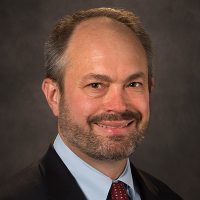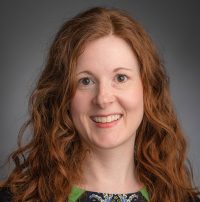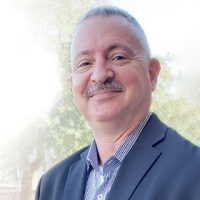Expert Panel:

Dr. William Wierda, President & CEO, CLL Global Research Foundation

Dr. Erin Parry, Investigator, Hematologic Neoplasia at Dana-Farber Cancer Institute

Jeff Folloder, Moderator and CLL patient advocate
Our recent CLL Global Research Foundation virtual town hall featured CLL Global President, Dr. William Wierda, and Dr. Erin Parry, an Investigator of Hematologic Neoplasia at Dana-Farber Cancer Institute. CLL patient advocate Jeff Folloder moderated the event. Watch the full webinar.
Transcript
Jeff Folloder:
But, Dr. Parry, you’re up next. I understand that some of your recent research with CLL Global focuses on Richter’s transformation. Can you tell us about that work?
Dr. Erin Parry:
Of course, and thank you again for having me today. So, today, I’m going to be talking about this event of histologic transformation.
This is something that, while I’m going to be talking about it in CLL today, and it’s obviously the focus here – it’s actually something that we see across many different cancers. It’s how cancer cells evolve or actually change their underlying cell type. So, this is something that you may also hear in other settings, although we’re talking, like I said, about it, particularly, in the setting of CLL today.
When this happens in CLL, the cells usually become a large B-cell type lymphoma or an aggressive lymphoma. We call that a Richter’s transformation or a Richter’s syndrome. This is something that we see even in the era of our exciting new treatments. But, hopefully, I can also share with you today that there’s a lot of new hope and a lot of new research coming together in this area.
So, this is one of the slides that I like to highlight when we talk about transformation. The exciting part, I think, about this slide is that we’re beginning to decipher many different angles or layers of sort of the underlying biology and why transformation occurs, looking at the genetics, looking at model organisms that allow us to study the process in depth, understanding epigenetic and genetic determinants, so different ways that the DNA can be impacted that contribute to this process, and then also how the immune system and immune systems surrounding CLL cells may influence or shape this process.
If you look at the dates on these different studies, the majority of them happened just in the last couple of years. So, I think our science is really starting to catch up. Hopefully, that’s going to lead to more knowledge and new ways of tackling this together.
So, one question that I sometimes get is – if we’re in this era of amazing genetic medicine and biology and unparalleled knowledge, why do we have so many questions remaining about transformation, and why are many of these studies only occurring in recent years? I think that’s because transformation has traditionally a little difficult to study for a couple of reasons.
The first one here, I think, is really thinking about, in order to properly be able to study it, we have to capture the CLL cells before transformation and then have a sample at the time of transformation to really understand what’s changing and what’s going on. That requires samples that have been stored properly and biobanks.
Also, this is a really rare thing in CLL. So, because of that, this isn’t something that can be studied by one person in isolation but really has to be studied by groups coming together. The other issue that has complicated things, I think, is this issue of sample admixture. If we’re looking and trying to decipher DNA or molecular changes, how do you know which cells they’re coming from?
This is because the transformation biopsies are usually a mixture of normal cells in addition to CLL cells in addition to immune cells and the Richter’s cells themselves. So, it really required us to build and innovate and create unique computational pipelines and tools that could be able to look when things are all jumbled up together to really understand what’s going on in which cell.
Also, now, as we’re moving forward as a scientific field, we have a lot of new technologies, and we can actually now look at a single cell level and ask what the single cell molecular changes are in a way that we couldn’t even five or 10 years ago. So, this is really helping accelerate our understanding in this area. I would also say that this has been a nice area to work in and really exciting as a physician/scientist/investigator because this is not something that can really be studied in isolation.
So, the studies that have gone on in this area have been really highly collaborative bringing together physicians and scientists and investigators, not only across the U.S. – it’s one way that I’ve gotten top work with Dr. Wierda, which has been a really wonderful experience – but also doctors in Europe and many other different places, as we all try to understand this together.
Then, also, sample banking efforts. So, I think, also, immensely grateful to patients with CLL in transformation that have participated in research studies that have allowed these samples to be collected so that people can begin to apply these new tools; and together, as a community, we can begin to understand this better.
So, I think now that we’re gaining this knowledge, one of the exciting questions that we continually can ask each other is – how can we take some of our advanced knowledge and better scientific understanding to make a difference for our patients with CLL? So, some of the questions that I’ve particularly tried to target with my CLL Global Research project have to do with – is there a way to improve diagnosis or recognition of Richter’s?
Is there a way to identify transformation risk? Because we know that the majority of CLL patients never have this happen. If there was a way to identify those few cases where we may want to keep a closer eye on people or if we knew that it was coming, could we someday stop it from happening? So, as you can see on this graphic here or cartoon, we know that this evolution happens over time. As we can begin to understand it better, we can hopefully get at some of those questions.
So, my CLL Global project has taken two new sensitive approaches for trying to detect transformation. The first is looking at these single cells, which I alluded to, with these novel technologies that allow us to pick up single molecular changes of DNA or RNA or genes that are in these individual cells and understand exactly everything that is happening on that process of evolution so that someday we might be able to detect it better and intercept it.
The other aspect is looking at cell-free DNA changes, so little pieces of DNA that actually belong to the Richter cells are actually shed into the blood. Sometimes, we can pick them up in the blood without doing an invasive biopsy. If we could do a simple blood test to be able to also sort some of these things out, that could help us maybe apply therapies better or do screening in the future.
So, thank you so much, again, for your support. I’m very appreciative to the CLL Global [Research] Foundation and all my colleagues in the field and many others who have really contributed.
Jeff Folloder:
Richter’s transformation, Richter’s syndrome, it is a very important topic. I suspect that’s not all that you’re studying through CLL Global. What else is capturing your attention?
Dr. Erin Parry:
So, a lot of my research has really been focused on the process of transformation but many different aspects.’
One of the things that was studied in collaboration with Dr. Wierda is also trying to understand things that impact immune response both in CLL and in Richter’s. So, I’m also very interested in trying to understand things that motivate the immune system to respond to cells, and how can we really harness the power of the immune system better. So, that’s another area that I’m very interested in.
I think also one of the things that’s coming on the horizon is being able to, again, continue collaborative efforts to really put together large sets of data and learn what we can so, hopefully, a lot to come that we can all contribute.
Jeff Folloder:
One of the things that I’m sensing from you and from Dr. Wierda and from, frankly, all the CLL investigators that I interact with, the tone has become much more optimistic, much more confident, the pall is not hanging over the conversation like it used to.
So, this is a great development for me. Dr. Wierda, is there something that you’d like to add to this before we get into several dozen questions?
Dr. William Wierda:
No, maybe just a couple things I would touch on that Erin didn’t mention. One is my impression has been that the number of cases of Richter’s transformation is decreasing. I think we still see Richter transformation, but we don’t have nearly as many cases as we used to when we were using chemotherapy to treat CLL. So, I’m glad to see that the incidence appears to be decreasing. I think it’s because we’re not using chemotherapy. Patients now are just getting just targeted therapy, and the risk for transformation is lower.
The other thing that I would mention is a phenomena that happens relatively infrequently but can be an important point, and that is most of the cases of Richter transformation occur because the leukemia cells, the CLL cells, have transformed into something more aggressive. It’s the same cell, but it’s transitioned into a more aggressive form. That’s the most common scenario.
But there is a less common scenario where it’s not arisen, the Richter transformation, those large cells have not arisen from the CLL but are an independent process that have come about independent of the CLL. That’s something that we call clonally unrelated. Those cases tend to be more sensitive to treatment, and we can potentially cure those types of Richter’s with chemotherapy, whereas the Richter’s that arise from the CLL, what’s referred to as clonally related, is a lot more difficult to treat.
It’s really resistant to chemotherapy and the most successful strategies have been immune-based allogeneic stem cell transplant, possibly CAR T-cell therapy. There’s some data with these checkpoint inhibitors that are immune modulators. So, we’re most excited about immune-based strategies for Richter transformation.

